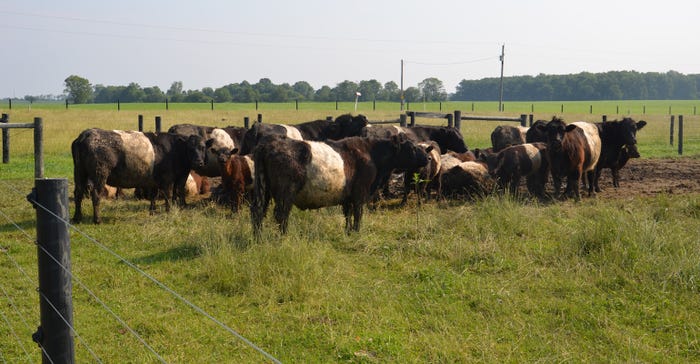May 25, 2017

According to Purdue University Extension forage agronomist Keith Johnson, there’s a fairly wide variation in how well livestock producers in Indiana manage their pastures. Generally speaking, where the quality of the pasture makes a major contribution to farm income through livestock, management practices tend to be better. In parts of the state where corn and soybeans rule, pastures can sometimes be a “stepchild.”
Whatever your situation, though, Johnson says doing a good job managing your pasture can be the difference between putting more dollars in your pocket and leaving them on the table.
“It’s difficult to put a dollar or percentage value on mediocre vs. excellent management,” he says. “But the difference in improved yield, quality, persistence and bottom-line profitability can really be quite significant.”
To help forage producers assess how well they’re doing, Johnson has a tool to help them evaluate their skills. It’s a guide that lists 10 best management practices, and you rate yourself on a range of qualitative responses using a scale from “strongly disagree” to “disagree” to “undecided” to “agree” to “strongly agree.” Or if you like numbers better, you can use 1 through 5.
Ready to see how see how you’re doing?
1. Do you soil-test every third year and fertilize based on test results?
Before you send your soil samples, tell the lab what type of pasture you have, because there’s a big difference between the nutrient requirements for grass and grass-legume pastures. Once you receive your results, the first thing to check is soil pH. For good grass production, it should be around 6.2; for grass-legume pastures, it should be from 6.6 to 7.0.
Then look at the rest of your analysis. If there’s one nutrient that’s particularly low, that’s likely your best dollar spent. Beware of “generic” or default nutrient recommendations, like an application of 300 pounds per acre of 12-12-12. Good recommendations need to be prescriptive, based on specific soil-test results. And be realistic about your yield goals. A 6-ton-per-acre estimated yield will get you a recommendation for more nutrients than a 4-ton pasture.
2. Do you know the pasture’s major soil types, and their strengths and weaknesses?
As the saying goes, “Alfalfa doesn’t like wet feet.” Knowing which forages to seed on which soil types can be a big deal. Johnson also prefers to soil-test by soil type. While grid-sampling may work for some pastures, many pastures are challenging because of their irregular shape. Knowing your soil type and soil tests can also help you target your manure applications to where they’re most beneficial.
3. Do you know the major forages, and their strengths and weaknesses?
“You need to get past just knowing that you have a grass pasture, and know what kind of grasses you have,” says Johnson. Do you have any legumes, and if so, how much and what kind? You also need to know what kinds of weeds you have, because some are more problematic than others. If you don’t address horse nettle, it can quickly take over your pasture. Poison hemlock has become a problem statewide. It doesn’t take much of that weed to create significant animal health problems.
4. Do you remove livestock when forage is about 4 inches high?
Horses are notorious for grazing a pasture down to where it looks like a putting green, but other species are also capable of similar feats. Once that happens, your pasture will transition to something different than what you had, and will likely include more weeds. Have a rotation plan for your paddocks, and move livestock off when the pasture gets down to 4 inches.
5. Do you stockpile perennial pastures in late summer and early fall?
Stockpiling forages on part of your pasture in late summer and early fall allows you to get your livestock off other paddocks from September through early November. Then you can rotate livestock back on to the rested paddocks in November and graze into January, thereby lengthening your grazing season and reducing your winter hay bill.
6. Do you evaluate pasture growth and potential concerns weekly?
Pastures should be scouted on a weekly basis to see what’s happening. Is lack of moisture taking a toll on forage growth? Are weed problems developing? Any insect or disease issues? In any case, finding out sooner rather than later will be much to your advantage.
7. Do you document when livestock are moved from paddock to paddock?
Seasons vary from year to year, as do moisture and temperature. Just because one week on followed by three weeks off worked well last year doesn’t mean that necessarily fits this year. Besides that, most producers’ memories aren’t infallible. Keep track of when livestock moves from paddock to paddock. Record it on your computer, on paper or in your mobile device, but record it somewhere!
8. Where possible and applicable, do you graze crop residues and double-crop forages to full potential on your farm?
If you can graze corn residues, and have adequate fences and water supply, you can get a great response for a late-winter or early-spring calving herd or sheep flock. Corn residues typically meet the nutritional needs of good body-conditioned cows and ewes in that gestation stage fairly well.
Also, double-cropping things like spring oats, sorghum-sudangrass, pearl millet, teff or forage turnips after wheat can create some fantastic annual forages for fall and winter grazing.
9. Do you analyze nutrient composition of your hay?
Whether you’re a feeder, buyer or seller of hay, it just makes sense — and dollars — to know what kind of feed you’ve got or are thinking about buying.
10. Do you have a forage agronomist on your list of professionals?
You work with professionals in other areas of your farming operation, so why not with your forages? If you can find an agronomist who knows forages and has a passion for them, it will make a difference in your bottom line.
Hay score epilogue
Apply numbers 1 through 5 to your responses. If you don’t get a 50, Johnson says you shouldn’t feel too bad. Although it’s attainable, few people would achieve that score.
“I would hope, however, that producers who take their pasture management seriously and who keep up on things would be able to score 40 or higher, which I would consider to be a B+,” he says.
Actually, the purpose of this exercise isn’t to see how high you can score, or how your score compares to others. Instead, it’s about seeing how you can do a better job of managing your pasture and making your operation more profitable, and seeing which areas you’re doing well in and which areas you can target for improvement. In many cases, making some improvements isn’t all that difficult, Johnson relates.
“I think everyone who raises livestock on pasture should … have access to a soil probe and a hay probe,” says Johnson. “If you have these two tools and learn how to use the information that comes from them, that’s a big step in the direction of increased profitability.”
Check out the slideshow below for more about these best pasture management practices.
Boone writes from Wabash.
About the Author(s)
You May Also Like






